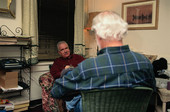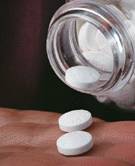| 
Preparing for a Chlorine Gas Disaster

WEDNESDAY, Jan. 7 (HealthDay News) -- On a January night in 2005, a freight train with three tanker cars -- each loaded with 90 tons of chlorine -- slammed into a parked locomotive in the center of Graniteville, S.C., a town of 7,000 people about 15 miles from Augusta, Ga.
One tank ruptured during the 2 a.m. collision, releasing between 42 tons and 60 tons of chlorine gas that seeped into a nearby textile mill, where 180 people were working the overnight shift.
Eight people died at the accident scene, at least 525 people were treated in emergency rooms, and 71 people were admitted to nine hospitals in South Carolina and Georgia.
A new study examining the lingering effects of the disaster should serve as a blueprint for larger metropolitan areas looking to prepare for an accidental or terrorist release of the potentially deadly gas, the researchers said.
"This is one of the largest community exposures to chlorine gas since World War I," study lead author David Van Sickle, a Robert Wood Johnson Foundation Health & Society Scholar at the University of Wisconsin, said in a news release issued by The American Journal of Emergency Medicine, which published the report in its January issue.
"It was a tragic disaster that shows us what a significant challenge a large-scale chlorine gas release poses to health-care facilities," he said.
Hospitals need to be able to quickly recognize the signs of chlorine exposure and have enough mechanical ventilators on hand, he added.
Van Sickle was part of a team from the U.S. Centers for Disease Control and Prevention and the South Carolina Department of Health and Environmental Control (DHEC) that studied the accident's resulting health effects.
Chlorine gas is an irritating, fast-acting and potentially deadly inhalant. It's also one of the most widely used toxic chemicals -- water treatment and industrial manufacturing are examples of such use. Much of the 13 million to 14 million tons produced in the United States each year is transported by rail, often through populated areas, the news release said.
New U.S. regulations governing the transportation of rail cargo aim to prevent a similar disaster in a major metropolitan area. And, the U.S. Department of Homeland Security has identified a deliberate attack on a chlorine storage tank as a top concern. According to agency estimates, as many as 100,000 people would be hospitalized and 10,000 would die if a chlorine storage tank was attacked in an urban area, according to the release.
Van Sickle and his colleagues tried to learn as much as they could about the health effects from widespread exposure to chlorine gas.
According to the report, many people who were hospitalized showed signs of severe lung damage. More than a third were admitted to intensive care, and 10 percent required mechanical ventilation. Despite their injuries, most recovered quickly and were discharged within a week, according to the release.
"Public health agencies and hospitals across the country can learn a lot from this disaster and be better prepared to help in the next emergency," Dr. James J. Gibson, state epidemiologist and director of the Bureau of Disease Control at the South Carolina DHEC and a co-author of the report, said in the news release. "We continue to monitor area residents for any possible long-term health effects."
More information
To learn more about chlorine, visit the U.S. Agency for Toxic Substances and Disease Registry.
|  |

More Than 60,000 Patients Risked Hepatitis Infections
 TUESDAY, Jan. 6 (HealthDay News) -- Failure to follow basic infection practices placed more than 60,000 U.S. patients at risk for hepatitis B and C, a new U.S. government review reported Tuesday.
The review, published in the Jan. 6 issue of the journal Annals of Internal Medicine, concluded that health care personnel in settings outside hospitals failed to follow basic infection control practices. Reuse of syringes and blood-contamination of medications, equipment and devices were identified as common factors, the study found.
Transmission of HBV and HCV while receiving health care had been considered uncommon in the United States, but the study revealed 33 identified outbreaks outside of hospitals in 15 states, during the past 10 years: 12 in outpatient clinics, six in hemodialysis centers, and 15 in long-term care facilities, resulting in 450 people acquiring hepatitis infections.
"This report is a wake-up call," Dr. John Ward, director of the U.S. Centers for Disease Control and Prevention's division of viral hepatitis, said in an agency news release. "Thousands of patients are needlessly exposed to viral hepatitis and other preventable diseases in the very places where they should feel protected. No patient should go to their doctor for health care only to leave with a life-threatening disease."
CDC officials said the findings showed the need for ongoing professional education and oversight for health care providers, as well as:
- Improving viral hepatitis surveillance, case investigation and
outbreak response.
- Strengthening state and local viral hepatitis prevention programs.
- Augmenting the CDC's National Healthcare Safety Network, the national surveillance system for tracking health care-associated infections, to collect outpatient setting information.
- Partnering with the Hepatitis Outbreaks' National Organization for
Reform (HONOReform), a patient advocacy foundation, to create patient and provider education materials.
- Working with partners in the dialysis, diabetes and long-term care communities to promote safe practices, and with regulators and professional societies to strengthen licensure and accreditation processes.
More information
Learn more about preventing viral hepatitis in health care
settings at the U.S. Centers for Disease Control and Prevention.
|  |

Researcher Finds Most Will Inflict Pain on Others If Prodded

MONDAY, Jan. 5 (HealthDay News) -- People today may be just as willing to follow orders to hurt others as they were nearly half a century ago, a new study finds.
In a replication of one of the most famous and controversial experiments in behavioral psychology, people were asked to give what they believed were increasingly painful electric shocks to others in the name of science. Just as occurred in the original experiment, a vast majority of the shockers continued to turn on the juice even though it appeared the people receiving the jolts were in pain.
The recent study, performed by Santa Clara University professor Jerry M. Burger, attempts to reproduce the obedience experiments of the late Stanley Milgram. The findings were published in the January issue of American Psychologist, which included a special section about Milgram's work 24 years after his death.
"People learning about Milgram's work often wonder whether results would be any different today," Burger said in a news release issued by the journal. "Many point to the lessons of the Holocaust and argue that there is greater societal awareness of the dangers of blind obedience. But what I found is the same situational factors that affected obedience in Milgram's experiments still operate today."
As in Milgram's 1961 experiments at Yale University, Burger's subjects were told they were helping to test the effect of punishment on learning. At the order of an authority figure, the subject would give what they were told were increasingly powerful electric shocks to another person in a separate room. In reality, the machine giving the shocks was a fake, and the authority figure and the receiver of the alleged shocks were in on the ruse.
In Milgram's experiments, 82.5 percent of the participants continued administering shocks even after hearing the first cries of pain at the alleged 150-volts level.
In Burger's replication, 70 percent also wanted to continue when they hit that same level. The difference between the two figures was not statistically significant.
In both experiments, men and women obeyed the orders to administer the shocks at similar rates.
The experiments weren't completely identical, though, because of ethical concerns and codes that have developed since Milgram's time. For example, Burger lowered the maximum "shock" level from 450 volts to 150 volts. He also screened out any potential participants who had taken more than two psychology courses in college, were familiar with Milgram's research or, based on an evaluation of a clinical psychologist, might have a negative reaction to the study procedure. The subjects in Burger's study were told at least three times that they could quit at any time and still receive $50 for participating in the experiment.
Several psychologists commenting in the same issue of American Psychologist questioned whether the two studies are really on the same level, though they said the new study still has value.
"Though direct comparisons of absolute levels of obedience cannot be made between the 150-volt maximum of Burger's research design and Milgram's 450-volt maximum, Burger's 'obedience lite' procedures can be used to explore further some of the situational variables studied by Milgram, as well as look at additional variables," wrote Alan C. Elms of the University of California, Davis, one of the people who assisted Milgram in 1961.
More information
The Milgram re-enactment has more about Stanley Milgram's original experiment  . .
|  |

Human Body May Make Its Own 'Aspirin'

WEDNESDAY, Dec. 31 (HealthDay News) -- Salicylic acid, the key component that gives aspirin its anti-inflammatory and pain-relieving properties, may be something humans can produce on their own, a new study suggests.
Salicylic acid (SA) previously had been found in the blood of people who had not taken aspirin recently -- especially vegetarians. This made sense because salicylic acid is a natural substance found in fruits and vegetables.
However, researchers in the United Kingdom who gave study participants benzoic acid, another natural substance in fruits and vegetables that the human body could use to produce salicylic acid, concluded that people can make their own SA based on the subsequent changes in the participants' SA levels.
Their findings appear in the Dec. 24 issue of the Journal of Agricultural and Food Chemistry.
"It is, we suspect, increasingly likely that SA is a biopharmaceutical with a central, broadly defensive role in animals as well as plants," the authors wrote in a news release issued by the journal's publisher. "This simple organic chemical is, we propose, likely to become increasingly recognized as an animal bioregulator, perhaps in a class of its own."
More information
The U.S. Food and Drug Administration has more about the risks and benefits of regular aspirin use.
|  |
|